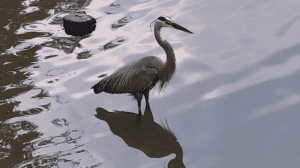The Arabia Mountain National Heritage Area is filled with dozens of rare and vibrant species, including some plant species found almost nowhere else on earth.
Birding In The NHA
With over 250 species of birds residing across Metro Atlanta and hundreds of millions of individuals migrating across Georgia each year, Atlanta is a birder’s dream. The Arabia Mountain NHA is home to many local and migrating avian populations and provides fantastic bird watching opportunities for beginners and experienced birders alike. Download the Birds Georgia (formerly Georgia Audubon) Checklist of the Birds of Atlanta or check out our Events Calendar for future birding opportunities.
Black-Spored Quillwort
The exposed rock outcrops of Arabia Mountain NHA harbor unique and rare plant species with unusual adaptations. One of these unique species is the black-spored quillwort (isoetes melanospora) or Merlin’s grass. This grass-like fern, only a few inches tall, grows submerged in water during the winter months. It withers in hot, dry weather but springs back to life sprouting new leaves, thin and quill-shaped, within a day of a summer thunderstorm.
This exceptional survivor is a federally endangered plant, found on Arabia Mountain and a handful of other granite outcrops and nowhere else in the world.
Days And Days Of Daisies
Every fall the mountain turns golden yellow and smells redolent of thousands of honey-scented blossoms. The Porter’s daisy or Stone Mountain daisy (helianthus porteri) is actually a rare species of sunflower. This tiny, sweet-smelling flower was confused for perennial daisies because of their petiteness and tendency to grow in almost the same spot (due to limited space in the cracks of the rocky outcrop). The Arabia Alliance celebrates this big annual bloom every September/October with Daisy Days, a series of daisy-themed hikes and events.
Discover Dramatic Diamorpha
Local monadnocks are rolling out the red carpet for you in April. Once each year a rare plant, diamorpha smallii, turns an eye-catching red before donning pure, white flowers. Although it is only a couple inches tall, this show-stopping plant blankets the mountain pools at Arabia with crimson. If you trek to the top of Panola Mountain you’ll be treated to isolated pools in a sea of green lichens and moss.
Granite Rock Stonecrop
Delicate and rare, granite rock stonecrop (sedum pusillum) has crystalline white blooms in the early spring and is perhaps the hardest to spot plant in the NHA. This rare and beautiful little plant needs a very specific environment to thrive; it grows typically in partial shade and in the presence of Eastern Red Cedar and White-Tipped Moss (hedwigia ciliata).
Granite Rock Stonecrop is found in very few places now because the plant has suffered habitat loss and degradation from quarrying and human activity. In the Heritage Area, these can mostly be found at Panola Mountain State Park in the early spring. Some have been spotted off the beaten path at Arabia as well.
Lichen or Rock Grasshopper
The Lichen or Rock Grasshopper (trimerotropis saxatilis) is a beautiful example of something that has evolved to thrive in the harsh, often hot environment on the rocky outcrops found in the Heritage Area. Small and hard to spot, they are seen occasionally at Panola Mountain on lichen-encrusted rockfaces, typically near the high points or summits. It is believed that the species feeds on the lichens it is found among.
Lovely Lichen
Lichen is a pioneer, the first organism to colonize exposed rock. It’s also not a plant but rather two organisms that live together in symbiosis: a fungus and a partner, such as algae, that provides energy through photosynthesis.
There are many species of lichen throughout the Heritage Area—gold dust lichen, old man’s beard, and peppered rock shield—and some can take years or even centuries to grow a small amount. Take care to stay on the gray and not touch or step on this key player in the ecosystem of the rock outcrop.
Mountains Of Moss
Moss is tiny and rootless but mighty. Local mosses, like this haircap moss community, trap dirt and dust in their stems, helping to build up soil that supports flowering annuals such as pineweed and yellow daisies. Arabia and Panola Mountains are covered in a wide variety of mosses. Other cool and unusual Heritage Area species include sausage moss, grimmia dry rock moss, and bright green dicranum moss.
Snorklewort
Snorklewort (gratiola amphiantha) or pool sprite is fun to say and has a fascinating life. This petite aquatic wort grows submerged in solution pits during the winter, where it flowers and produces seeds. Like diamorpha, the seeds are dormant during the hot summer and begin their life cycle when rain and cool weather return. The name comes from the threadlike stem capped with tiny blossoms and leaves that just break the water’s surface like a snorkel. (Just don’t ask us why it’s spelled differently.)
Like black-spored quillwort, snorklewort is federally endangered and found few other places in the world. Its habitats have been threatened by quarrying, off-road vehicles and dumping of trash.
So Many Salamanders
During the fall and early spring, salamanders breed around Arabia Mountain, including in the frog pond at the Nature Center. This pond is the result of quarrying and fills with water during the winter and spring and at other times of abundant rainfall.
The Davidson-Arabia Mountain Nature Preserve has two less common species of salamanders: the spotted salamander and the marbled salamander. Both are mole salamanders, spending most of their adult lives underground. During breeding, the female finds a small body of water and extrudes a colorless gelatinous cloud filled with dozens of eggs, and the male then fertilizes this egg mass. Please don’t touch egg masses as they contain nature’s next generation of salamanders.





















